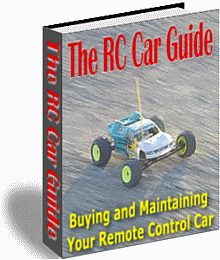GAS POWERED REMOTE CONTROL CAR
Touring cars have 4 wheel independent suspension, 4 wheel drive, and 2-speed transmissions capable of propelling car to speeds in excess of 50 mph. Gas powered cars use 2-stroke engines. For 1/8 scale, .21 size engines are used. For 1/10 scale, .12 size engines are common. Engines for these cars come either with a pull-start (PS) or non-pull start. Pull-start engines have a built-in recoil starter to pull the wire or rope to turn the engine's crankshaft. For non-pull start engines, you will need to have a starter. The end of the starter is a rubber wheel, which is "bumped" against the flywheel of the engine to turn the crankshaft. Using a starter on a pull-start engine may damage the pull-start mechanism.
Nitro fuels are specially blended fuel for RC gas cars. All RC car models have guide books in which appropriate fuel for them is recommended. It is also advisable to use a consistent fuel type for a car as it helps the engine to give optimum performance. Chaging fuel types may disturb the engine performance of the car.
Fuel is also classified according to nitro content. Higher the nitro content more is the power. Fuel with only 10% nitro is good enough to win races and is cheaper than fuel with 15 - 20% nitro. The nitro engines use a glow plug (similar to a spark plug of a real engine). To start the engine, this glow plug must be heated. A device called a glow driver or igniter, powered by a 1.5v battery, is used to heat the glow plug.
The radio control unit is the electronics that control the speed and direction of the car. A basic radio controller consists of transmitter, receiver, servos and battery holder for the receiver, on/off switch, servo horns and batteries.
Use of quick, quiet and easy to afford, build and drive electric vehicles are still the most popular choice in R/C power for first-time modelers. Equipped with a rechargeable Nickel-Cadmium (NiCad) battery pack, a vehicle with a stock motor will provide about 6-8 minutes of run time. With multiple packs and a quick charger, an electric vehicle is ready for hours of use.
Even after the preference to electric vehicles interest in gas vehicles has grown enormously over the period of time. Vast improvements in glow engine technology have simplified tuning and maintenance, enabling many more modelers to enjoy the realistic sound and smell that goes along with gas power's acceleration and speed. Buying a fail safe unit is an inexpensive option that can save your gas car from damage.
Visit our sponsor
http://rcracecar.online-business-idea.com

